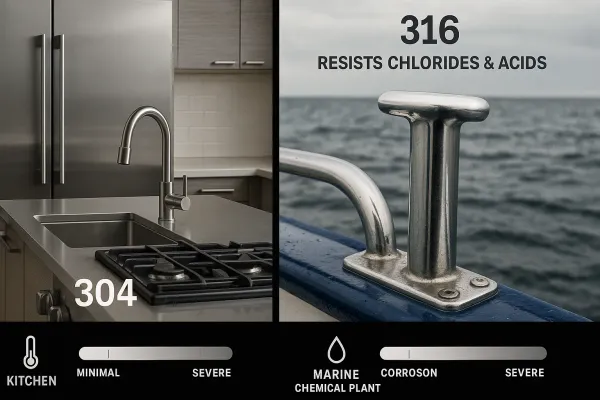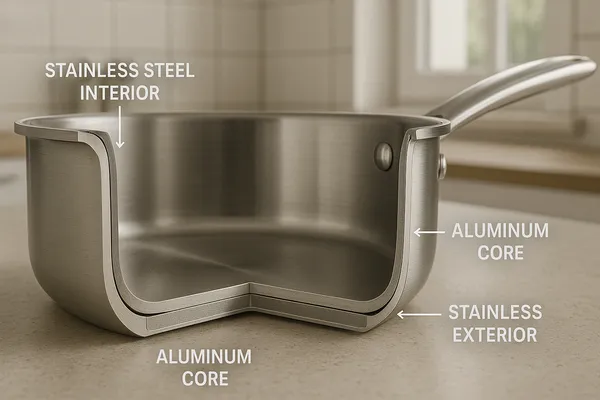Choosing the wrong stainless steel costs money and credibility—rusted welds, failed pumps, product recalls. Relax: the right grade stainless prevents corrosion headaches, saves budgets, and earns repeat customers.
The best stainless steel depends on environment. 304 stainless steel suits indoor, mildly corrosive, or food‑contact uses. 316 stainless steel—with molybdenum—delivers superior corrosion resistance against chlorides, acids, and high temperatures, making it ideal for marine, chemical, and pharmaceutical applications. Match grade to exposure, temperature, and budget.

Stainless steel is an alloy of iron plus ≥ 10.5 % chromium and controlled nickel. Chromium reacts with oxygen, forming a self‑healing oxide film that withstands scratches and harsh chemicals. Additives such as molybdenum or nitrogen* boost resistance to pitting.
| Property | Why It Matters | Typical Range |
|---|---|---|
| Corrosion resistance | Stops rust and corrosion in food, marine, and chemical processing | Varies by stainless steel grade |
| Strength | Carries load without deformation | 210–600 MPa (annealed) |
| Heat tolerance | Withstand high temperatures before scaling | 870 °C (304) / 925 °C (316 SS) |
| Hygiene | Smooth surface resists bacteria | Food & pharma |
Industry stat: Global stainless output hit 62.6 million t in 2024—up 7 % YoY. China alone poured 39.4 Mt. (worldstainless)
Need deeper chemistry tables? Visit stainless steel grade guide.
304 stainless steel—an austenitic stainless steel with chromium and 8 % nickel—is the most commonly used stainless steel for:
304 offers:
Case study – A beverage OEM swapped carbon steel skids for 304. Maintenance hours fell 22 % over 12 months, ROI in 8 months.
Add 2–3 % molybdenum and ≥ 10 % nickel content: 316 stainless steel leaps ahead with superior corrosion resistance.
Perfect for:
Seawater contains ~19 000 ppm chloride ions—enough to pit 304 in weeks.
In a Red‑Sea desalination plant, our grade 316 stainless pipes ran 5 years leak‑free versus competitors’ 304 which failed at year 2.
Need polished sanitary 316 tube? See 316 cost analysis.
Mixes austenitic stainless and ferritic stainless steel phases:
Learn more in our duplex stainless overview.
Low‑nickel 430 stainless steel is magnetic stainless, budget‑friendly, yet less resistant than 304.
| Grade | Magnetic? | Typical Use | Note |
|---|---|---|---|
| 430 stainless steel | Yes | Oven backs, induction‑ready cookware bottoms | Must avoid chloride splash |
| 304 stainless | No (annealed) | Sinks, tanks, tubing | Better hygiene |
| 316 stainless steel | No | Marine grade pumps, valves | Highly resistant to salt |
Need cold‑rolled coils? Check our 430 coil inventory.

Small tweaks in chemistry deliver big performance jumps. Chromium builds the passive film; nickel stabilises the austenitic stainless matrix; molybdenum tightens the lattice, offering superior corrosion resistance in acids and brine.
Highlights
Chefs, dairy engineers, and brewery owners value food grade stainless steel because it neither reacts with acids nor sheds flavour‑spoiling ions.
| Grade | Typical Food Use | Why It Works |
|---|---|---|
| 304 stainless steel | Brewing kettles, milk tanks | Resistant to corrosion in low‑chloride liquids |
| 316 stainless steel | Pickle vats, soy sauce lines | Superior corrosion resistance against salt & vinegar |
| 430 stainless | Sandwich bottom of stainless steel cookware | Magnetic—works on induction hobs |
“Switching to 316 SS cut brine‑tank failures from yearly to once a decade.” – QA Manager, condiment factory

Keep your projects crack‑free and hygienic.
Need laser‑cut blanks fast? Tap our CNC fabrication service—48‑hour turnaround for up to 20 mm plate.
| Question to Ask | If “Yes” → Recommended Grade |
|---|---|
| Exposure to chloride > 200 ppm? | 316 stainless steel or duplex stainless |
| Design temp > 500 °C? | 304 (short term) or 310S |
| Weight‑saving critical? | Duplex (yield 2× 304) |
| Budget tight, indoor dry air? | Grade 430 stainless |
Remember: The grade of stainless steel shapes lifetime cost more than purchase price. Select once. Save forever.
How does grade 304 SS differ from grade 430 stainless?
304 is austenitic stainless, non‑magnetic, higher nickel, better resistance to corrosion. 430 is ferritic stainless steel, magnetic, cheaper, but less resistant to salt.
Is duplex stainless steel difficult to weld?
Not if you keep heat input low and use matching duplex filler; the balanced microstructure retains strength and resistance to oxidation.
Can I replace carbon steel with stainless and skip painting?
Yes—stainless steel is a versatile material that forms a protective film, so no paint needed; overall lifecycle cost drops.
Why is 316 SS called marine grade?
Its molybdenum addition offers excellent corrosion resistance in seawater, outperforming 304 by 10× in ASTM G48 tests.
Which stainless steel type handles both high acidity and high temperature?
316 SS or duplex grades with added molybdenum—making it suitable for pressure cookers and acidic CIP cycles.
How do surface finishes affect hygiene?
A 2B or BA finish keeps the surface of stainless steel smoother; bacteria adhesion falls 60 % compared to mill‑scale plate.
Are Glass Balustrades a Good Idea? The Ultimate Modern Glass Railing System for Balconies and Staircases
Stainless Steel Tube Manufacturers: Seamless, Alloy & Stainless Steel Tubing Explained
Welded Stainless Steel Tubing & Tube: 304 Stainless, 321, OD/Wall Thickness and Pipe Specs
Stainless Steel Handrail Design:Stainless Steel Handrail & Railing Ideas for Your Stair